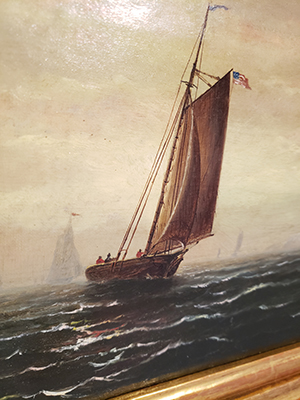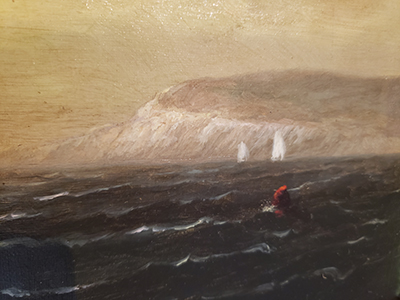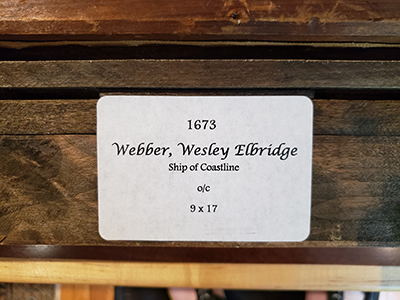Description
Ship on Coastline
Oil on Canvas
9 x 17
Marine, landscape and historical painter, Wesley Elbridge Webber was born in Gardiner, Maine, in 1841. Considered self-taught, Webber began his career after a move to Boston, Massachusetts, where he apprenticed himself to J. C. Roberts, a successful sign and carriage painter from 1858 to 1861. He then opened and maintained his own fine art studio in Boston, with annual painting excursions to the Conway area of New Hampshire until a move to New York City in 1892.
His Conway excursions brought him into a close circle of artists, including J. J. Enneking and Frank Shapleigh, who helped Webber shape a personal style of a sophisticated realism as the group explored the lush, mountainous hills and valleys of this scenic part of New Hampshire. During this period Webber exhibited widely with exhibitions at the Boston Art Club, the National Academy of Design, the Brooklyn Academy, the Peabody Museum in Salem, and the Portland Museum, Maine.
At the outbreak of the Civil War, Webber volunteered to serve in Company B of the Sixteenth Maine Volunteer Regiment present at General Robert E. Lee’s surrender at Appomattox Courthouse. As the only artist present on the Northern side of the conflict, Webber dashed off a number of detailed sketches which were later reproduced as lithographs and later wood engraving in Harper’s Weekly, the most popular periodical in America at the time of the Civil War. J. H. Bufford, of Boston, also printed a large and very popular lithograph of the surrender that made Webber a celebrity overnight.
A large group of his original drawings together with lithographs, woodcuts and paintings were exhibited at the Boston Art Club, confirming Webber’s unique role as the artist who captured Lee’s surrender and the end of the War between the States. On June 15, 1865, Webber was discharged from the Army. He immediately opened a new studio in Gardiner, Maine, where his mature style was appreciated with exhibitions in Boston and New York City.
Later Webber’s New York City studio, located at 11 East 14th Street, quickly became a meeting spot for a number of hard-drinking realist painters working in New York after the turn of the century. In 1914, Webber, suffering from the effects of alcoholism, left the city for Wollaston, Maine, and the home of his only daughter where he died that same year. The contents of his studio numbering over 140 finished paintings were sold at auction in 1915 in Boston by C. F. Libbie and Company.
Webber’s paintings are now included in most large regional American museums including the Boston Athenaeum, the Peabody Museum, the Brooklyn Museum, the New York Public Library, the Metropolitan Museum, and the Portland Museum, Maine. Little is known or recorded about Webber’s travels in North America or his trips abroad although paintings with place names found in Manchester-by-the-Sea, and other parts of maritime Canada, the Yosemite area of the American West, and an important group of atmospheric paintings done during winter in Venice, Italy, in the late 1890s, suggest that Webber was exploring impressionistic variations of his polished realist style with a group of silvery nocturnes of St. Mark’s Square seen from the Grand Canal and captured as light falls and the glow of the city takes over.
Webber is included in most standard reference works on American painting including the two-volume Index of Artists, Mantle Fielding’s Dictionary of American Painters, Zellman’s 300 Years of American Painting, and the Exhibition Record of the National Academy of Design 1861-1900
Written and submitted by Gary R. Libby art historian and author










Reviews
There are no reviews yet.